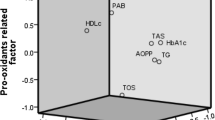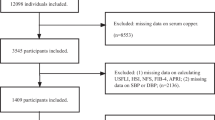Abstract
Chronic liver disease (CLD) is associated with the destruction of liver parenchyma cell. It is the main cause of morbidity and mortality in most of the developed countries. Oxidative stress and altered levels of different trace elements in serum have been documented for different diseases including inflammation and many liver diseases. This study aims to evaluate the serum level of malondialdehyde (MDA), nitric oxide (NO), antioxidant vitamin C, C-reactive protein (CRP), and zinc (Zn) in CLD patients and to establish a correlation among the study parameters with the severity of inflammatory conditions of CLD. In this study, CLD patients and healthy volunteers were recruited. Total cholesterol and triglyceride were determined by colorimeter using enzymatic method. Serum non-enzymatic antioxidant vitamin C, reactive oxygen species nitric oxide (NO), and malondialdehyde (MDA) were determined by UV-spectrophotometric method. Trace element (Zn) levels were determined by graphite furnace atomic absorption spectroscopy. Independent sample t test and Pearson’s correlation test were performed for statistical analysis using the statistical software package SPSS, Version 20. Studies showed that the MDA (p < 0.001), NO (p < 0.001), and CRP levels were significantly higher in CLD patients than in control subjects. The antioxidant vitamin C (p < 0.001) and trace element zinc (p < 0.001) were comparatively lower in the CLD patients than in control subjects. Elemental Zn showed an inverse relationship with MDA, NO, and CRP but positively correlated with antioxidant capacity, whereas MDA showed a positive correlation with CRP level. Thus, we conclude that attenuated level of Zn and antioxidant in serum play an important role in the inflammatory status of CLD patients by elevating the concentration of MDA, NO, and CRP.
Similar content being viewed by others
References
Allan R, Thoirs K, Phillips M (2010) Accuracy of ultrasound to identify chronic liver disease. World J Gastroenterol 28:3510–3520
Cerra FB, Siegel JH, Border JR, Wiles J, McMenamy RR (1979) The hepatic failure sepsis cellular versus substrate. Surgery 86:409
Opara EC (2006) Oxidative stress. Dis Mon 52:183–198
Negre-Salvayre A, Coatrieux C, Ingueneau C, Salvayre R (2008) Advanced lipid peroxidation end products in oxidative damage to proteins. Potential role in diseases and therapeutic prospects for the inhibitors. Br J Pharmacol 53:6–20
Comporti M, Arezzini B, Signorini C, Vecchio D, Gardi C (2009) Oxidative stress, isoprostanes and hepatic fibrosis. Histol Histopathol 24:893–900
Del-Rio D, Stewart AJ, Pellegrini N (2005) A review of recent studies on malondialdehyde as toxic molecule and biological marker of oxidative stress. Nutr Metab Cardiovasc Dis 15:316–328
Vuppalanchi R, Juluri R, Bell LN, Ghabril M, Kamendulis L, Klaunig JE, Saxena R, Agrwal D, Johnson MS, Chalasani N (2011) Oxidative stress in chronic liver disease: relationship between peripheral and hepatic measurements. Am J Med Sci 342:314–317
Abrams GA, Trauner M, Nathsnson MH (1995) Nitric oxide and liver disease. Gastroenterologist 3:220–233
Vallance P, Moncada S (1991) Hyperdynamic circulation in cirrhosis: a role for nitric oxide? Lancet 337:776–778
Leoni G, Rosato A, Perozzi G (2014) Zinc proteome interaction network as a model to identify nutrient-affected pathways in human pathologies. Genes Nutr 9:436
Rink L, Haase H (2007) Zinc homeostasis and immunity. Trends Immunol 28:1–4
Grungreiff K, Reinhold D, Wedemeyer H (2016) The role of zinc in liver cirrhosis. Annals Hepatology 15:7–16
Maret W, Sandstead HH (2006) Zinc requirements and the risks and benefits of zinc supplementation. J Trace Elem Med Biol 20:3–18
Blazewicz A, Dolljiver W, Sivasmmye S, Deol A, Randhawa R, Oelicz-Szczesna G, Blazewic R (2010) Determination of cadmium, cobalt, copper, iron, manganese and zinc in thyroid glands of patients with diagnosed nodular goitre using ion chromatography. J Chromatogr B 878:34–38
Blazewicz A, Orlicz-Szczesna G, Prystupa A, Szczesny P (2010) Use of ion chromatography for the determination of selected metals in blood serum of patients with type 2 diabetes. J Trace Elem Med Biol 24:14–19
Mohamad NS (2013) Trace elements homeostatic imbalance in mild and severe psoriasis: a new insight in biomarker diagnostic value for psoriasis. Our Dermatol Online 4:449–452
Disilvestro RA (2000) Zinc in relation to diabetes and oxidative disease. J Nutr 130:1509S–1511S
Bao B, Prasan AS, Beck FWJ, Fitgerald JT, Snell D, Bao GW, Singh T, Cardozo LJ (2010) Zinc decreases C-reactive protein, lipid peroxidation, and inflammatory cytokines in elderly subjects: a potential implication of zinc as an atheroprotective agent. Am J Cli Nutr 91:1634–1641
Black S, Kushneri I, Samols D (2004) C-reactive protein. J Biol Chem 279:48487–49490
Satoh K (1978) Serum lipid peroxide in cerebrovascular disorders determined by a new colorimetric method. Clin Chim Acta 90:37–43
Lowry H, Jeanne A, Lopez OA (1945) The determination of ascorbic acid in small amounts of blood serum. J Biol Chem 162:609–615
Miranda KM, Espey MG, Wink DA (2001) A rapid simple spectro-photometric method for simultaneous detection of nitrate and nitrite. Nitric Oxide 5:62–71
Sultana GNN, Khan AH (2008) Direct determination of aluminum and zinc in serum by graphite furnace Zeeman effect background correction. Eurasian J Analy chem 3:2
Pfeiler S, Molinari E (1982) The CRP-range latex test. A new method for the semiquantitative determination of C-reactive protein in serum. Z Rheumatol 41:54–56
Giannini EG, Testa R, Savarino V (2005) Liver enzyme alteration: a guide for clinicians. CMAJ 172:367–379
Ghadir MR, Riahin AA, Havaspour A, Nooranipour M, Habibinejad AA (2010) The relationship between lipid profile and severity of liver damage in cirrhotic patients. Hepat Mon 10:285–288
Mehboob F, Ranjiha FA, Masud S (2007) Changes in serum lipid profile among patients suffering from chronic liver disease. Annals 13:3
Pujar S, Kashinakunti SV, Gurupadappa K, Manjula R (2011) Serum MDA, antioxidant vitamins and erythrocytic antioxidant enzymes in chronic alcoholic liver disease—a case control study. Al Ameen J Med Sci 4:315–322
Mah E, Matos MD, Kawiecki D, Ballard K, Guo Y, Volek JS, Bruno RS (2011) Vitamin C status is related to proinflammatory responses and impaired vascular endothelial function in healthy, college-aged lean and obese men. J Am Diet Assoc 111:737–743
Yadav D, Hertan HI, Schweitzer P, Norkus EP, Pitchumoni CS (2002) Serum and liver micronutrient antioxidants and serum oxidative stress in patients with chronic hepatitis C. Am J Gastroenterol 97:2634–2639
Van de Casteele M, Zaman Z, Zeegers M, Servaes R, Fevery J, Nevens F (2002) Blood antioxidant levels in patients with alcoholic liver disease correlate with the degree of liver impairment and are not specific to alcoholic liver injury itself. Aliment Pharmacol Ther 16:985–992
Prasad AS (2014) Zinc is an antioxidant and anti-inflammatory agent: its role in human health. Front Nutr 1:14
Beck FWJ, Prasad AS, Kaplan J, Fitzgerald JT, Brewer GJ (1977) Changes in cytokine production and T cell subpopulations in experimentally induced zinc deficient humans. Am J Phys 272:1002–1007
Cervoni JP, Thevenot T, Weil D, Muel E, Barot O, Sheppard F, Monnet E, Di Martino V (2012) C-reactive protein predicts short-term mortality in patients with cirrhosis. J Hepatol 56:1299–1304
Yoneda M, Mawatari H, Fujita K, Iida H, Yonemitsu K, Kato S, Takahashi H, Kirikoshi H, Inamori M, Nozaki Y, Abe Y, Kubota K, Saito S, Iwasaki T, Terauchi Y, Togo S, Maeyama S, Nakajima A (2007) High-sensitivity C-reactive protein is an independent clinical feature of nonalcoholic steatohepatitis (NASH) and also of the severity of fibrosis in NASH. J Gastroenterol 42:573–582
McClain C, Su LC (1983) Zinc deficiency in the alcoholic: a review. Alcohol Clin Exp Res 7:5–10
Prystupa A, Blazewicz A, Kininski P, Sak JJ, Niedzialek J, Zaluska W (2016) Serum concentrations of selected heavy metal in patients with alcoholic liver cirrhosis from the Lublin region in eastern Poland. Int J Environ Res Public Health 13:582
Acknowledgments
The authors are thankful to all physicians, staffs, and nurses of the Department of Medicine, Jononeta Nurul Hoque Adhunik Hospital, Noakhali, Bangladesh, for their technical and administrative support during the study.
Author information
Authors and Affiliations
Corresponding author
Ethics declarations
Institutional ethical committee approved the study protocol (# BS58/2015). Written consent was taken before data collection.
Conflict of Interest
The authors declare that they have no conflict of interest.
Rights and permissions
About this article
Cite this article
Uddin, M.G., Hossain, M.S., Rahman, M.A. et al. Elemental Zinc Is Inversely Associated with C-Reactive Protein and Oxidative Stress in Chronic Liver Disease. Biol Trace Elem Res 178, 189–193 (2017). https://doi.org/10.1007/s12011-016-0919-5
Received:
Accepted:
Published:
Issue Date:
DOI: https://doi.org/10.1007/s12011-016-0919-5




